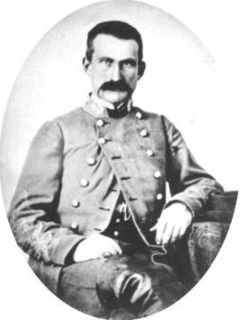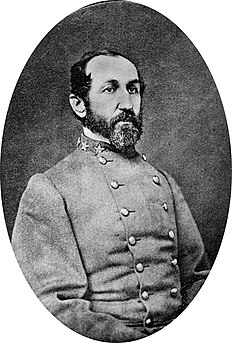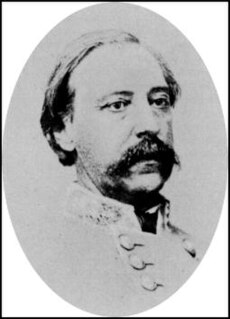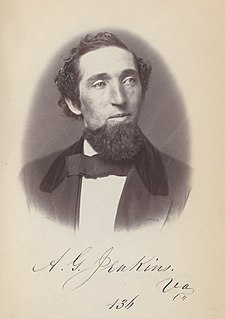
Nathan Bedford Forrest was a prominent Confederate Army general during the American Civil War and the first Grand Wizard of the Ku Klux Klan from 1867 to 1869. Although scholars generally acknowledge Forrest's skills and acumen as a cavalry leader and military strategist, he has remained a controversial figure in Southern racial history, especially for his main role in the massacre of over 300 black soldiers at Fort Pillow coupled with his post-war role in leading the Klan.

Eufaula is the largest city in Barbour County, Alabama, United States. As of the 2010 census the city's population was 13,137.

Joseph "Fighting Joe" Wheeler was an American military commander and politician. He is known for having served both as a cavalry general in the Confederate States Army in the 1860s during the American Civil War, and then as a general in the United States Army during both the Spanish–American War and Philippine–American War near the turn of the twentieth century. For much of the Civil War he served as the senior cavalry general in the Army of Tennessee and fought in most of its battles in the Western Theater.

Patrick Ronayne Cleburne was an Irish-born American soldier, best known for his service in the Confederate States Army during the American Civil War, where he rose to the rank of major general.

Raphael Semmes was an officer in the Confederate Navy during the American Civil War. Until then, he had been a serving officer in the US Navy from 1826 to 1860.

Stephen Dill Lee was an American politician who served as the first president of Mississippi State University from 1880 to 1899. Prior to that, he was lieutenant general of the Confederate States Army in the Eastern and Western theaters of the American Civil War.

George Washington Gordon was a general in the Confederate States Army during the American Civil War. After the war, he practiced law in Pulaski, Tennessee, where the Ku Klux Klan was formed. He became one of the Klan's first members. In 1867, Gordon became the Klan's first Grand Dragon for the Realm of Tennessee, and wrote its "Precept," a book describing its organization, purpose, and principles. He was also a member of the United States House of Representatives for the 10th congressional district of Tennessee.

John McCausland, Jr. was a brigadier general in the Confederate army, famous for the ransom of Hagerstown, Maryland, and the razing of Chambersburg, Pennsylvania, during the American Civil War.

Indian Mound Cemetery is a cemetery located along the Northwestern Turnpike on a promontory of the "Yellow Banks" overlooking the South Branch Potomac River and Mill Creek Mountain in Romney, West Virginia, United States. The cemetery is centered on a Hopewellian mound, known as the Romney Indian Mound. Indian Mound Cemetery is also the site of Fort Pearsall, the Confederate Memorial, Parsons Bell Tower, and reinterments from Romney's Old Presbyterian Cemetery. The cemetery is currently owned and maintained by the Indian Mound Cemetery Association, Inc.

Josiah Gorgas was one of the few Northern-born Confederate generals and was later president of the University of Alabama.

Goode Bryan was a planter, politician, military officer, and American Civil War general in the Confederate States Army. His brigade played a prominent role during the Battle of the Wilderness, fighting stubbornly until exhausting its ammunition.

Albert Gallatin Jenkins was a Virginia attorney, planter, slaveholder, politician and soldier from what would become West Virginia during the American Civil War. He served in the United States Congress and later the First Confederate Congress. After Virginia's secession, Jenkins raised a company of partisan rangers and rose to become a Confederate brigadier general, commanding of a brigade of cavalry. Wounded at the Battle of Gettysburg and again during the Confederate loss at the Battle of Cloyd's Mountain, Jenkins died days after his arm was amputated by Union surgeons. His former home is now a museum operated by the West Virginia Division of Culture and History.

William Tatum Wofford was an officer during the Mexican–American War and a general in the Confederate States Army during the American Civil War.

Pinckney Downie Bowles was a lawyer, county prosecutor, probate judge, and a Confederate military officer during the American Civil War.

Henry DeLamar Clayton, Sr. was a prominent Alabama attorney, politician, Redeemer judge, and college president. He also served as a major general in the Confederate Army during the American Civil War, commanding a division in the Army of Tennessee in the Western Theater.

John Herbert Kelly was, at the time of his promotion, the youngest brigadier general in the Confederate States Army. He became one of the youngest generals to die during the American Civil War, at the age of 24. His death occurred during an engagement at Franklin, Tennessee on September 2, 1864 during Major General Joseph Wheeler's raid into Tennessee in August and early September 1864 in an attempt to destroy the railroad that Union Army Major General William Tecumseh Sherman was using to supply his force from Chattanooga, Tennessee during the Atlanta Campaign.
The 13th Arkansas Infantry (1861–1865) was a Confederate Army infantry regiment during the American Civil War. Organized mainly from companies, including several prewar volunteer militia companies, raised in northeastern Arkansas, the regiment was among the first transferred to Confederate Service, and spent virtually the entire war serving in Confederate forces east of the Mississippi River. After the unit sustained heavy casualties during the Battle of Murfreesboro, the unit spent most of the rest of the war field consolidated with the 13th Arkansas Infantry Regiment, to form the 5th/13th Arkansas Infantry Regiment.

Tyree Harris Bell was a Confederate States Army brigadier general, during the American Civil War.

Daniel Harris Reynolds was a Confederate States Army brigadier general during the American Civil War. He was born at Centerburg, Ohio but moved to Iowa, Tennessee and finally to Arkansas before the Civil War. He was a lawyer in Arkansas before the war. After the war, Reynolds resumed his practice of law and was a member of the Arkansas Senate for one term.
In Lee's Last Retreat: The Flight to Appomattox, historian William Marvel identified Private Pleasant Riggs Crump, of Talladega County, Alabama, who died December 31, 1951, as the last confirmed surviving veteran of the Confederate States Army. Citing English professor and biographical researcher Dr. Jay S. Hoar, Marvel states that after Crump's death a dozen other men claimed to have been Confederate soldiers, but military, pension, and especially census records prove they were impostors. Marvel further wrote that the names of two other supposed Confederate survivors alive in April 1950, according to Hoar, are not on the Appomattox parole lists and one, perhaps both, of their Confederate service claims were faked. An extensively researched book by Frank L. Gryzb, The Last Civil War Veterans: The Lives of the Final Survivors State by State, published March 29, 2016, supports the conclusion by Dr. Hoar, Mr. Marvel, Mr. Serrano and others that Pleasant Crump was the last confirmed and verified surviving veteran of the Confederate States Army.




















